Kelly Chiu Gives us 6 Reasons to Devour Ryōko Kui’s Delicious in Dungeon
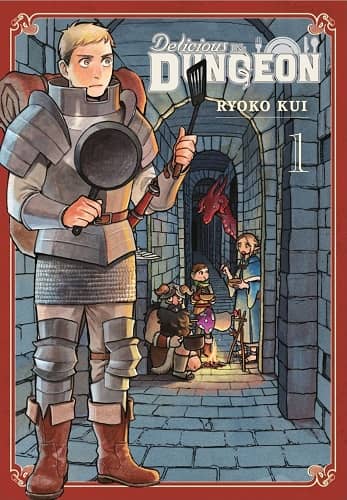 |
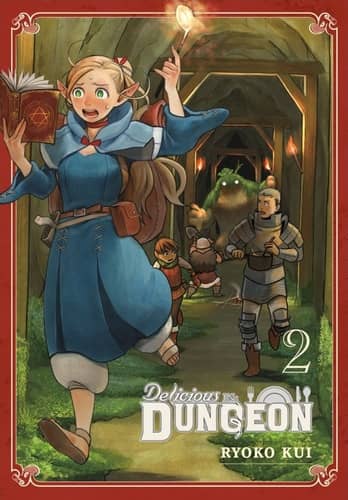 |
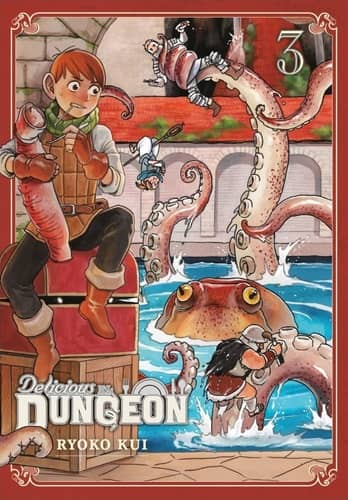 |
Every few years I promise myself I’m going to do a better job keeping up with the latest fantasy manga, but I never really do. But last year I did manage to discover the delightful Delicious in Dungeon, written and illustrated by Ryōko Kui, and I consider that a major win.
Delicious in Dungeon is a Japanese fantasy comedy about a 6-member adventurer party very nearly wiped out in a Total Party Kill deep in a dungeon. In the last moments before she’s swallowed by a dragon, the magic-user Falin uses the last of her strength to teleport her brother Laios and the rest of the party to the surface. Defeated and demoralized, and faced with the loss of most of their coin and equipment, two members quit immediately, but Laios convinces the last two to join him in a desperate sprint back into the dungeon before his sister is digested and beyond the reach even of the most powerful healing magic. Famished and too penniless to provision, Laios concocts a foolhardy plan to eat the monsters they encounter on their way down.
That’s the basic set-up for a extremely imaginative and frequently hilarious dungeon romp featuring three hapless foodies in a gloriously elaborate monster haven. The setting in fact is a huge part of the charm of this series, and it will be warmly familiar to anyone who’s played D&D or a similar early RPG, with its crowded underground markets and well stocked trading outposts scarcely 50 yards from trap-infested monster gardens. The slimes, mushroom men, man-eating plants and other oddball creatures they come up against will also bring back fond memories of the classic dungeon delves of your youth. They’re delightfully wacky, just like the plans our heroes come up with to eat them.
Late last year Kelly Chiu at the Barnes & Noble Sci-Fi & Fantasy Blog wrote a fine piece on the series, just before the English translation of the sixth volume arrived in stores. Kelly has a sharp sense for what makes the series so appealing to old school gamers and general comic fans alike, and in 6 Reasons to Devour Delicious in Dungeon she hit on many of the things I most enjoy about it. Here’s a few of her most on-target comments.
[Click the images for dungeon-sized versions.]
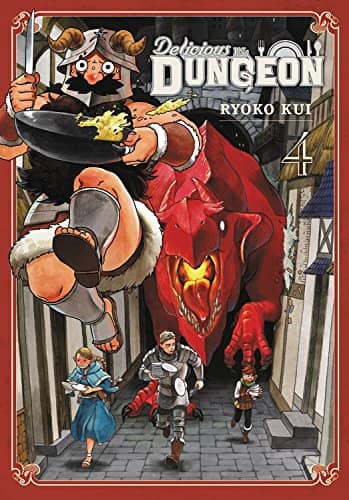 |
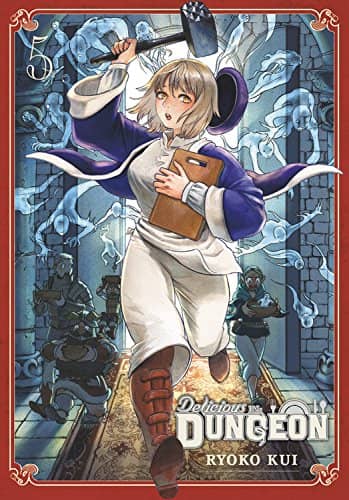 |
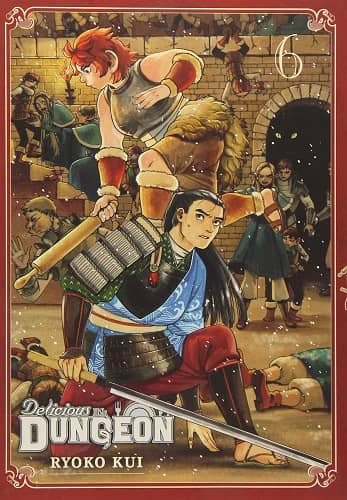 |
First, Kelly touches on one of the main selling point of the series for me — just how well it hits all my gaming buttons.
All the Fun of an RPG for Half the Price!
Ever wish you could enjoy your D&D campaign as a black and white comic? Well now you can! Delicious in Dungeon has all the classic RPG features: your knight, your mage, your healer, your slimes, your orcs, and your elves. Explore dungeons, win treasure, slay beasts! The series takes the JPRG-style setting that’s deluged the market in recent years — think Sword Art Online, Grimgar of Fantasy and Ash, or Konosuba — and retains the gamified mechanics, fantasy setting, and adventure, but adds a ridiculous foodie twist.
Strangely, magically, Delicious in Dungeon doesn’t feel like a parody. It pays tribute to the conventions of old school role playing, yes, but mostly affectionately. Instead the humor arises from the characters and their predicaments.
Laios and his teammates are doomed to certain starvation — at least until they run into Senshi, a dwarf who’s been living in the dungeon for over a decade, and has learned the secret of how to dine well on what it provides. What would be a one-note joke in less creative hands becomes instead a wonderfully faux-authentic experience, with a narrative that veers off into elaborate recipes for mouth-watering monster-based cuisine. Seriously — this is a comic about eating monsters that will make you hungry.
Senshi shows his new companions the right way to prepare dungeon scorpion
A book about eating monsters wouldn’t be very interesting if the monsters weren’t both interesting and varied. How on earth are our heroes going to turn that iron golem into a meal? It’s one more twist in a constantly-surprising narrative. Here’s Kelly again.
Fantastic Beasts and Where to Find Them
In a manga about cooking monsters, there have got to be monsters (duh). Kui populates her dungeon with all your favorite fantasy fauna — we’re talking slimes, living armor, basilisks, man-eating mermaids, and yes, fire-breathing dragons. Kui’s creature design is one of the artistic highlights of this series, which is saying something, as the art is already a highlight in and of itself. As a manga that focuses on farm-to-table (er… dungeon floor-to-adamantine cauldron?) meals, Kui has thought through the dungeon ecosystem in rather ingenious detail, introducing capsule-farm golems (their mud is perfect for growing veggies) and scavenging treasure insects that fuel the dungeon circle of life.
As entertaining as the mix of comedy and gaming nostalgia is, a book this well executed would be missing something without a nuanced story. Fortunately, creator Ryōko Kui is too clever and ambitious for that. Here’s Kelly.
Secrets to Be Revealed
Delicious in Dungeon is for the most part an episodic manga composed of short adventures ending in a shared meal of dried slime or a lesson in the household economies of kelpie-derived soap. But just as Kui has put a considerable amount of thought into the ecology of her dungeon wildlife, she’s clearly done some tinkering with the dungeon mechanics as well. As the manga progresses, our characters are increasingly wading into seemingly shallow streams that turn out to have much deeper currents — the magic of the dungeon, the politics of explorer bands, and secrets in our heroes’ pasts. Don’t get me wrong, this series is 90 percent a hilarious romp through basilisk omelets and boiled mimics, but hints of more serious questions add a welcome depth of flavor to a delicious meal of a manga.
Read Kelly’s complete comments at the Barnes & Noble Sci-Fi & Fantasy Blog here.
Delicious in Dungeon is written and illustrated by Ryōko Kui, and translated and published in the US by Yen Press. Issues appear quarterly; six have been published so far, the most recent in November 2018. The US editions contain seven comics each, plus a short “Miscellaneous Monster Tales;” they are presented in traditional manga format (meant to be read right to left). Each volume is 192-200 pages, priced at $15 in trade paperback and $6.99 in digital formats. The covers are by Ryōko Kui.
See all our recent Comics coverage here.
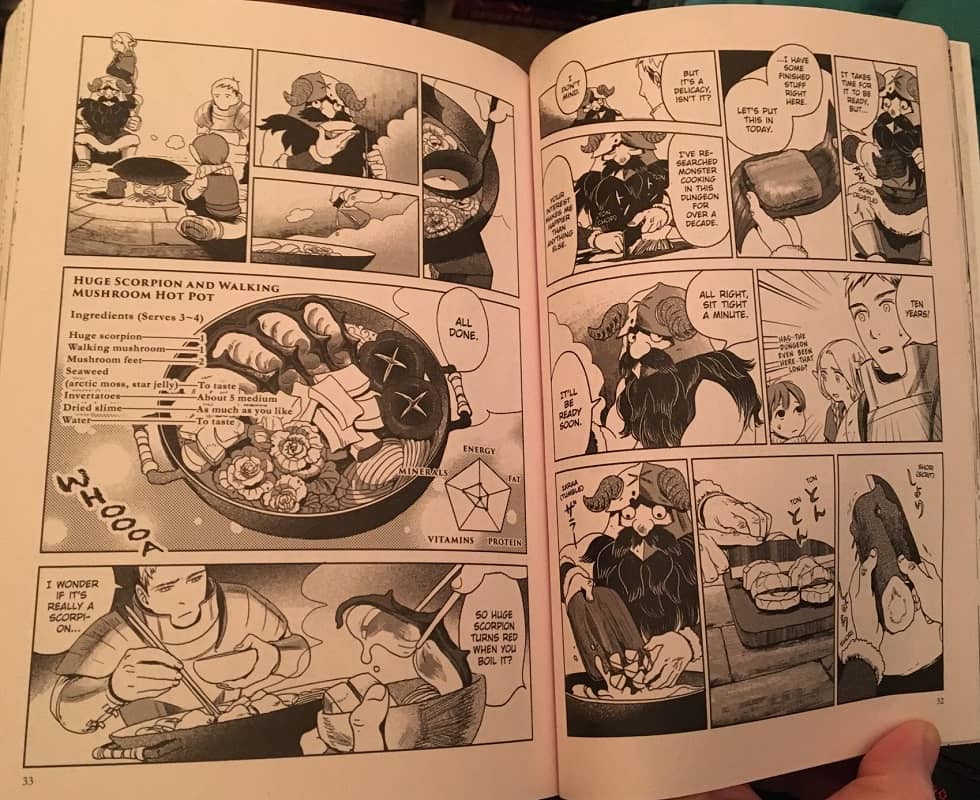
This sounds great. I’ll definitely check this out.
Anybody out there have other recommendations for dungeon-based manga? I didn’t even know this was a thing.
Would this be an appropriate read for an 11-year-old? I know just the kid who might be the ideal reader…hm, unless a lot of lizards get eaten. Lizards are pets, not food, around here.
Sarah,
I think so, especially if it’s a relatively mature 11 year old. I don’t recall any language or adult situations. The books are rated T for Teen.
Mind you, in her article Kelly makes a point that the target audience is intended to be older. Here’s Point #2 in her article:
Leave the Kids at Home
Delicious in Dungeon is a seinen manga, meaning its target demographic is older than the spirited shonen creations that tend to dominate the Western market. That Kui is writing for a 20-plus audience is obvious from a quick look at the ages of her characters, who are all unquestionably adults with fully-formed personalities, who treat their dungeon crawling more as a day job than a grand world-saving adventure. Not that we don’t all love an impetuous shonen scamp, but it’s nice to see an elf worried about paying the bills once in a while.
Japanese Fantasy Manga was always influenced by western media.
It’s an “Arabesque” of writers of the east – what we call “SilkPUNK” here these days. Makes me wince for both the accursed “—PUnk” issue and the distraction.
“Arabesque” is a better term – a dream of a far off and strange land that might or might not exist or have existed. The “Arabian Nights” got this term coined, and note that they themselves are “Arabesques” of other lands, other places. I think the setting of the story is ancient India though presumably one of the Muhgal rulers and other stories are set in other lands – Aladdin for instance is supposed to be set in China. (the TV movie got that right)
Now, Japan has its own rich mythological and folk tradition to go with its violent history. Especially popular is the Warring States period and post era – as if our “Wild West” was mixed with the Middle Ages. But to a creative writer other lands can appeal also.
Western fantasy, especially Dungeons and Dragons, has influenced Japan greatly. Notice the near dominance of Japanese RPGs for computer games – you can even get construction kits like RPG Maker. Thinking of using one of these for a project for mine, but learning how to work the setup so they look more regular/western. Another issue, of course.
Then there was the anime “Record of Lodoss War”, inspired literally by a college Dungeons and Dragons campaign. Heh, I’m more imagining my RPG sessions which did have some awesome moments but plenty of YouTube parody, like the guy rolling for initiative and casting magic missiles when still in the tavern.
Or.. well… “HoodyHoo, let’s go find the HEAD of Vecna!!!”
The Anime itself, while their own tradition has plenty of commercial cartoon art (Ukiyo-E) of all subjects was highly influenced by Disney. It only seemed so foreign in that they allowed culturally cartoon exaggeration on otherwise serious realistic stories – and the stories weren’t “Kids stuff or nothing” which Disney ended up doing with his influence.
Its a crazy ride if you check out Japanese fantasy obviously inspired by Western stuff but the writers/artists don’t know what they are doing. No offense, we’d make stuff just as “What the…..!?” making our own Samurai era stories. Funny how they can do ours but SJWs/Triggered College fake idealists scream “Haalp us! Theyz non-politically correct! Cultural ah-propriations!” when Westerners do it…
Myself I love seeing foreign interpretations of western culture, you should look up on YouTube “Moira” by “Sound Horizon” – they got inspired by Greek Tragedy and made a bizarre rock opera heavy on acting.
But for the crazy ride – well “Slayers” is most accessible – start with the first season then go forwards – usually on Hulu. Vampire Hunter D is another. But for stuff you might not know about – well “Monster Collection” and “Culdecpt” – each a fiction to promote a game/card game – but they let the artist/writer just use the elements and run wild, making a really neat story. Monster Collection is brilliant dark fantasy and Culdecpt is lighter. There’s the “Guin Saga” – anime/manga. For post apocalypse stuff we have things like “Sarai” and “Eat Man”. Then there’s really “Style over substance” where the art and pacing is excellent but the story is kinda lacking but its still an enjoyable ride – “Kurohime”, “Sword of the Dark Ones”, “Testatharoso” – I could go on all night literally – lots out there.
A favorite Anime that has a weird connection to western RPG’s – “Queen’s Blade” – doubtless IF anyone here has seen it they’ve dismissed it as the ‘fan service’ its usually judged for. But it has a deeper meaning.
Years back, like late 70s, early 80s as RPGs were taking off there was this game called “Lost Worlds” where it focused on combat between various characters by cards that randomly determined which strength/weakness they had. They had Skeleton, Warrior, Genie, etc. Went on for a while, fizzled out. BUT some Japanese guy bought the set on a business trip and loved it. A decade later he’d made a bunch of money and found a way to contact the owner of the property and bought the rights. Then well Japan …. He released the system but yep, “Fan service” and proud of it. Lots of busty female warriors. Ecchi meaning certainly sexual appealing, not for little kids but not XXX material. And as it got popular some mangas, an Anime series and LOTS of fan works and fan comic books which since Japan has looser copyright laws people can draw and sell and get away with – but most producers there consider it a status symbol how many “Doujins” they have of their works as actors in the USA count pyscho stalkers.
Well the “Queen’s Blade” would play right with the classic “Lost World” characters and the anime even made some tributes to them. Also western fantasy/RPGs – the main character in the Anime is a princess from the “Vance” family… By the by – although extreme ‘fan service’ the Queen’s Blade Anime would win the “Bechdel Test” big time.
The current fashion seems to be the “Examining Itself” phase – a type of “Deconstruction” on when a genre gets overworked so the foundational holes are obvious and the stories seem repetitive. Thus it is healthy to tear down the idols, try different things, but then build up again. IMO these various turn of the plots are good – there’s also one about finding dates during adventures, stories from the villian’s perspective being the hero, etc. Worthy of “Marshall Law” and “Batman The Dark Knight Returns”. My complaint from our end is the “West” didn’t really recover from the deconstructionist late “New Wave” – it’s still bashing old tropes while shoving ‘social justice’ down the dwindling readers throats and unwilling to go back to the ‘adventure’ and ‘fun’ parts only associating it with the racism and sexism of the past or rather fearing the absence of the aggressive “Social Justice” guidelines. One man’s opinion.
There is something in the bookstores currently I think readers here might like to look through: “Hakumei & Mikochi: Tiny little life in the woods” – by Takuto Kashiki – just a really neat fantasy comic, the title is pretty explanatory. No extreme stuff but really engaging and excellent artwork. Good cute escapism. Really its “What if Brian Froud was a Manga artist” almost. I’d almost want to give him that book, but wouldn’t want to disrupt his unique vision. If I wasn’t way way too busy with my own projects this book would make me want to get out my book on making faeries with modelling clay to make Froud like characters and scenes akin to this book.
Green,
I appreciated the comment on Arabesques, and found that very interesting.
However, 90% of your comments — like this one — end up degenerating into an attack on SJWs and PC culture, or derail the discussion for 15 paragraphs on a wild tangent.
I’ve discussed this with you before. At this point, I’m simply going to delete any comment of yours that mentions PCs, SJWs, or is longer than 3 paragraphs. I hope that solves this problem.
These certainly look interesting. A friend of mine once played a character who developed a penchant for snacking on what he killed.
I can’t recommend any fantasy manga but on a a slightly different tangent I quite enjoyed the euro style Path of the Damned. A Glorathan based comic. Sadly only three issues exist. For black and white dungeon crawl comedy sadly “kill” (Knigts of the Dinner Table Illustrated) stopped after about 40 issues. Would love it if Kenzer brought that publication back.